Water Quality Monitoring & Management
Water quality of the Lower Gabilan Watershed has been a focus area for staff at CCWG for well over a decade. This area encompasses a large range of landuse including: urban development in Salinas and Castroville; agriculture, particularly intensive row crops such as strawberries and leafy greens; natural wetlands and open space, which used to dominate the landscape but are now found only in fragments. This area is also home to some of the most polluted waterbodies in the state. To deal with these problems, Best Management Practices (BMPs) are put in place by farmers, municipalities and residence. CCWG has an ongoing interest to support the inventory and research of BMPs to address both urban and agricultural sources of non-point source pollution.
Greater Monterey County IRWMP-Round 2 Implementation: Salinas Storm Water Management: Increasing Capture, Improving Treatment, Reducing Energy Use, 2019-2023, DWR
This Project is a series of improvements to the City of Salinas’s Industrial Wastewater Treatment Facility (IWTF), with the ultimate goal of increasing the functionality of this facility for multiple water resource and environmental benefits.
The Project updates three components of the facility: 1) separating source water types entering the facility to enhance the efficiency of treatment; 2) removing nitrate and phosphates from water leaving the facility before it reaches the Monterey One Water (M1W) Regional Treatment Plant (RTP); and 3) improving flood protection for the power infrastructure to run the facility. Specifically, the Project will:
1) M1W will conduct a condition assessment and subsequent rehabilitation of an abandoned-in-place 33-inch pipeline. The 33-inch pipeline provides an opportunity to utilize existing infrastructure to achieve energy savings by repurposing the pipeline for separate storm water conveyance, allowing the storm water to bypass unnecessary aeration. Use of the 33-inch pipeline will also allow for capture of up to 300 AFY more storm water during peak storm events. This use will increase percolation to the groundwater basin, reduce flood risks in the Salinas River downstream of the Salinas outfall, and maximize recycling in the summer by increasing the amount stored during wet periods when recycling demands are lower.
2) Treatment Wetland Pilot Study: The Central Coast Wetlands Group (CCWG) will construct an initial water treatment system at the IWTF consisting of a treatment wetland chamber in series with several pilot phosphate removal chambers, and will assess its functionality to determine the most cost-effective phosphate removal process.
3) Electrical Components Flood Protection: City of Salinas will make improvements to select IWTF electrical components associated with the influent pump station, enhancing its flood and climate resilience.
The project is expected to result in the following outcomes: 1) increased storm water capture (up to 300 AFY) and increased use of the IWTF storage and percolation; 2) estimated 10% reduction in overall energy consumption of the IWTF; 3) additional TMDL compliance for the City and associated water quality and habitat improvements in the Salinas River; 4) improvement in downstream flooding conditions; 5) ensured system operability of the influent pump station, resulting in prevention of direct discharge of industrial wastewater to the Salinas River and allowing for continued operations of industrial processors year-round; and 6) better information to optimize treatment of industrial wastewater.

Evaluating agricultural management practices benefiting the Monterey Bay: reducing nutrient loads and Harmful Algal Bloom (HAB) events, 2020-2023; USEPA STAR Program
Objectives: We will demonstrate the effectiveness of farm runoff treatment systems in reducing nutrient discharges to coastal waterways and provide a blue print for scaling-up treatment systems within two key agricultural watersheds of the Monterey Bay. This project will support successful compliance with water quality regulations. In addition, this project will examine the potential link between agricultural nutrient discharges and the growth of harmful algal blooms (HAB). This link will be examined through the study of phytoplankton physiological response to specific discharges and effects of watershed scale loading on HAB events in the Monterey Bay.
Approach: A combination of field measurements and laboratory experiments will be used to achieve these four objectives. Water quality surveys will be performed above and below treatments/farms to quantify the effectiveness of existing technologies to guide future improvements in installations and maintenance, determine the ability of these technologies to address fertilizers other than nitrates, and investigate implementation strategies of priority management actions for individual farms to watershed scale cooperatives. We will combine data produced by this proposed study with river and wastewater data from the Central Coast Long-term Environmental Assessment Network (CCLEAN) to estimate total riverine and municipal loads of nutrients to Monterey Bay. We will complete mesocosm lab experiments and field sampling of HAB events to demonstrate how the selected nutrient management strategies will best achieve a reduction in offshore HAB response.
Expected results: 1) Expand the watershed monitoring systems to document progress towards water quality objectives. 2) Estimate the scale of nutrient removal and/or treatment needed to reduce HAB impacts to Monterey Bay. 3) Recommend the appropriate nutrient management practices (type, distribution and scale) to minimize near shore HAB response and determine the appropriate sub-watershed locations to implement these measures. 4) Document the primary nitrogen constituents and threshold concentrations needed to initiate a HAB response. 5) Work with industry, coastal resource managers and state agency staff to encourage the adoption and implementation of recommended nutrient management practices. 7) Integrate findings into regional watershed plans, referenced in regulations, presented to industry and published in peer review journals.

Lower Salinas Valley Water Quality Improvement Project, 2019-2022; SWRCB
An abiding concern in the lower Salinas River watershed is nitrates associated with runoff from the agricultural production to which the landscape is primarily dedicated and for which it is world-renowned. The Central Coast ‘Basin Plan’ and ‘TMDL for nitrogen and orthophosphate for the lower Salinas River and reclamation canal basin, and the Moro Cojo Slough subwatershed’ have been developed by the Central Coast RWQCB framing the water quality concerns and recommending actions to address them. This project includes installation of two new vertical flow woodchip denitrification bioreactors along Blanco Drain and three linear treatment wetlands to augment a multi-stage treatment wetland complex along Castroville Slough, followed by two years of management and monitoring and on-farm water and nutrient management tracking to confirm the projects’ water quality improvement effectiveness, enable modifications, and prepare the landowners for the ongoing management and maintenance of the projects beyond the life of the grant.
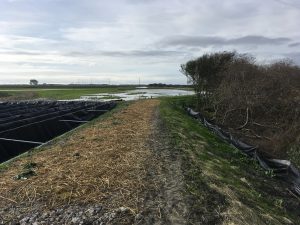
Nutrient Management Cooperatives in California’s Lower Salinas and Monterey Bay, 2017-2022; USDA NRCS CIG Program
Surface water quality targets are particularly challenging to meet and manage in intensively cultivated, irrigated and tile-drained landscapes. The current system of regulating individual producers has failed to meet water quality targets. Cooperative approaches that allow producers to understand nutrient transport through their watersheds, and pool resources to efficiently reduce nutrient loading through strategic implementation of on-farm practices and off-farm treatment areas (e.g., constructed wetlands, bioreactors, and vegetated drainages) are a promising alternative to the current system. Many on-farm practices and off-farm treatments have been proven to be effective at mitigating nutrients, but they are often too expensive for individual producers to apply. The overall goal of this project is to establish a cooperative model for pooling resources to comply with water quality regulations, making conservation practices more widely applicable in high-value, irrigated agricultural lands. The cooperative approach acts as a framework for strategic and spatially explicit modeling, siting, and monitoring of on- and off-farm treatment areas. The approach would add value to NRCS’s programs, including EQIP, by providing a governance structure that links implementation of voluntary conservation practices with streamlined regulatory compliance, increasing the efficiency and affordability of program implementation.
Links to Deliverables:
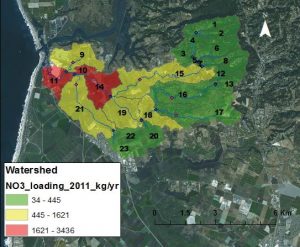
Moro Cojo Slough Watershed - Soils Water and Assessment Tool (SWAT) Model, 2014-2017; TNC
Growers, regulators, and other stakeholders have a strong incentive under the Ag Order to find effective solutions for improving water quality runoff, particularly nutrients. The Central Coast Wetlands Group at Moss Landing Marine Labs, in partnership with The Nature Conservancy, growers, and regulators, is working to develop a cooperative approach to manage nutrients along the central coast. Understanding nutrient fate and transport in the Moro Cojo watershed, including the impact of legacy groundwater inputs, will help identify cooperative management strategies for water quality improvement.
Objectives of the nutrient transport model:
- Collect and evaluate the best data available for the Moro Cojo watershed, including elevation, soils, land-use, fertilizer application, tile drain discharge, stream flow, crop management, etc. Using available data, model the fate and transport of nutrients through the Moro Cojo watershed. Identify data gaps and collect necessary samples in the field to calibrate and verify model.
- Evaluate cooperative management strategies of nutrient runoff using off-farm treatment wetlands and identify the most effective size and locations for treatment based on model outputs.
- Present results to help growers identify the best locations for off-farm natural solutions to improve water quality and habitat (constructed wetlands), and with on-farm improvements, will help the Regional Water Quality Control Board recognize cooperatives approach to meet the agency’s regulatory obligations.
- Deliverables:
- Tasks 1-10
- Data Sources
- Final Report
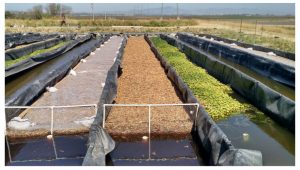
Effectiveness Study of Multiple Off-farm Treatment Practices for Specialty Crop Farmers, 2014-1017, CDFA Specialty Crop Block Program
The Salinas Valley supports farming of specialty crops including multi-year perennials (strawberries and artichokes) and annuals (leafy greens and broccoli) in constant production, leaving little opportunity for field fallowing. These intensive agricultural operations have led to impaired water quality for which the Central Coast Regional Water Quality Control Board (RB3) has developed a regulatory Agricultural Order, known as the Conditional Waiver of Waste Discharge Requirements for Discharges from Irrigated Lands (Ag Order). The Central Coast Wetlands Group (CCWG) and partners have demonstrated load reduction potential of off-farm treatment systems (bioreactors, treatment wetlands, etc.) based on the results of local pilot projects over the past decade. However, data from these pilot projects, along with studies in other parts of the U.S.A., are difficult to compare between system types because field variables including pollutant load, flow and retention time and temperature are inconsistent among studies. The purpose of this Treatment Effectiveness Project is to study the nutrient load reduction potential of several off-farm treatment systems for the management of water quality within the Salinas Valley.
Project Goals:
- Construct a working laboratory of four treatment measures, replicated three times each, for statistical validation; (Complete, see Attachment A: Photo documentation of Construction and Operations of Multi-Chamber Bio Reactor)
- Establish decay rate/load reduction estimates for each of the three discrete management measures and a control; (Complete, See Attachment B: Project Design and Sampling Results for Multi-Chamber Bioreactor Research Project and Attachment E: Multi-Chamber Bioreactor Model-based Analysis)
- Dissemination of results to various users; (Complete: See Attachment C: List of presentations and partners who have received information on intended nutrient reduction rate estimates of the project during 2016-2017)
- Integration of load reduction estimates into a watershed-based alternative compliance strategy. (Complete: See Attachment D: Draft Lower Salinas Valley Water Quality Cooperative).
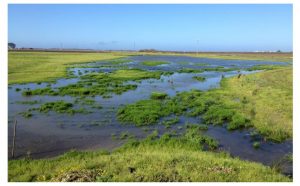
Salinas Valley Irrigation and Nutrient Management Program, 2013-2017; SWRCB
The INMP grant from the State Water Board, managed by the Regional Water Board, was for on-farm management of water resources as well as implementation of-off farm treatments. The Resource Conservation District of Monterey County as well as the UC Cooperative Extension implemented on-farm assessments and projects, while CCWG focused on constructing off-farm and edge-of-farm projects such as wetlands and bioreactors. The Monterey Bay National Marine Sanctuary conducted coordination and monitoring. The goal of this project was to provide technical assistance to farmers as well as improve water quality from non-point source pollution.
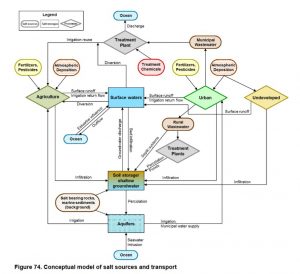
Salinas River Watershed Area Salt Assessment, 2013-2015; USEPA and SWRCB
With Funding from USEPA Region 9 and the Central Coast Regional Water Quality Control Board (CCRWQCB), CCWG worked with Tetra Tech on an assessment of salt impairments and development of a salt mass balance in the Lower Salinas River and Reclamation Canal watersheds. This effort can inform development of salt-related TMDLs by the CCRWQCB and a salt and nutrient management plan for the Salinas Valley aquifers.
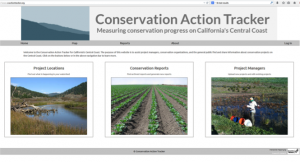
Central Coast Conservation Action Tracker
The Central Coast Action Tracker is an effort between the Greater Monterey County Regional Water Management Group including CCWG, and the Central Coast Resource Conservation Districts. The Action Tracker is an online tool that allows project proponents to register and update information on conservation projects such as BMPs across the region in order to track efforts and improve stakeholders’ ability to evaluate collective impacts and effectiveness. The vision is to provide detailed information on various conservation and water quality related projects throughout the Central Coast.
CCWG and the Project Team have been working on the building blocks for this website for several years, by gathering input on the content and functional input and output requirements of a tracking system. A database was designed to accommodate various project types from a wide range of organizations. We developed the tracking forms, uploaded relevant GIS data, and have begun entering projects. The site is intended to grow as more and more people realize it’s utility and begin to enter projects.
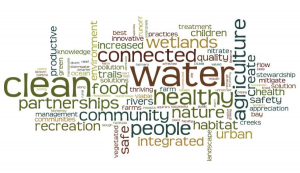
Greater Monterey County IRWMP-Round 1 Implementation: Water Quality Enhancement of the Tembladero Slough and Coastal Access for the Community of Castroville
Wetlands, whether naturally occurring or designed for treatment purposes, have an incredible ability to improve water quality degraded by non-point source pollution through filtering and breakdown of nutrients, pesticides and other pollutants. Vegetated treatment wetlands have been used to treat wastewaters worldwide for over 50 years and have been proposed as a Best Management Practice for water quality improvement in the Moro Cojo, Elkhorn Slough and Salinas Valley watersheds (Vymazal, 2010; Habitat Restoration Group, 1996; ABA consultants, 1989). For more about how treatment wetlands work, see our Wetlands page.
CCWG received funds through the Round 1 IRWMP implementation grant. This is a large project that is allowing CCWG to coordinate, plan and permit 12 or more acres of treatment wetlands in the lower Tembladero, Moro Cojo and Blanco Drain Watersheds. The final acreage could be achieved through one large or multiple small sites. This is very unusual in the grant world, typically a grant will require implementation of a project as well as design and permitting. However, our region prioritized this project because there is a recognized need for more treatment projects, but there are a lot of barriers to building them in this County. We are working with a number of landowners on potential sites in the project area, and hope to be able to exceed the 12 acres required of the grant.
- Link to Final Report:
- Link to Final Design Plans:
- Link to Castroville Community Outreach Component
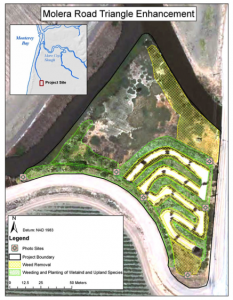
Molera Road Treatment Wetland
This wetland site was created in collaboration with The Watershed Institute at CSUMB and the Monterey County Water Resources Agency. It was designed to be used as an experimental outdoor laboratory looking into the nutrient and pesticide removal capabilities of wetlands. Several masters theses have been conducted at this site through CSUMB. Construction of the sinuous berms that created the upper wetland was completed using a small bulldozer in late 2005. Several thousand native wetland and upland plants were planted in early 2006, including bulrushes, on the banks and on 1-meter wide submerged berms installed across the channel in several places. By 2006, the bulrushes were approaching 3 m in height, lining approximately 75% of the length of the channel bank.
Research from Masters Students at CSUMB has been key to proving the effectiveness of wetland at cleaning non-point source pollution. Pam Krone-Davis found diazinon, methomyl and acephate pesticides were reduced by about 30%, while Gwen Miller found that mean nitrate was taken from 21.6 mg/l to 13.9 mg/l through the sinuous channel and is often undetectable by the time it exits the lower wetland, though there is possibly some groundwater interaction. Invasive species and a consistent source of water from the adjacent Tembladero Slough have created ongoing impediments to proper function of this demonstration wetland. With ongoing effort and adaptive management, we have acheived the proper functioning of the wetland and for the continuation of research including:
- protozoa pathogens and their removal in the wetland
- nutrient dynamics of the wetland’s groundwater
- gas cycling, particularly greenhouse gasses

